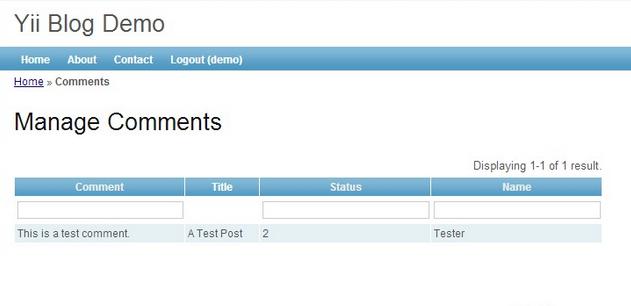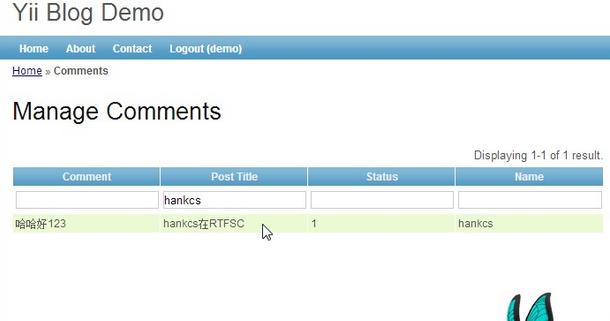Yii中CGridView 关联表搜索排序方法详解
在Yii CGridView 关联表搜索排序实现方法有点复杂今天看了一老外写的了篇游戏,下面我整理一下与各位朋友分享一下,希望文章对大家有帮助
首先,检查你的blog demo里的protectedmodelsComment.php,确保Comment模型有一个search的方法,如果没有,就用gii生成一个,我下载到的blog demo里倒是没有。
然后,写代码的时间到了,我们从 CommentController 开始,我们给它加一个 actionList:
<?php
public function actionList() {
$model = new Comment('search');
$model->unsetAttributes();
if (isset($_GET['Comment'])) $model->attributes = $_GET['Comment'];
$this->render('list', array(
'model' => $model,
));
}
?>着看起来没什么了不起的,跟你用gii生成的crud代码里的一样。现在让我来创建view,在 /protected/views/comment/ 目录下创建list.php然后粘贴以下代码
<?php
$this->breadcrumbs = array(
'Comments',
);
?>
<h1>Manage Comments</h1>
<?php
$this->widget('zii.widgets.grid.CGridView', array(
'dataProvider' => $model->search() ,
'filter' => $model,
'columns' => array(
'content',
'post.title',
'status',
'author'
) ,
));
?>Comment List
这是一个基本的 CGridView 只显示评论的'content', 'status' and 'author', 和文章的标题。我们假设想要往这张list里添加一列文章的标题,我们只需要添加post.title 就行了:
'columns'=>array( 'content', 'post.title', 'status', 'author', ),
现在如果你访问以下这个页面,发现文章的标题的确显示出来了

问题
如果你仔细瞅瞅这个页面你会发现你无法搜索文章标题,你也没办法按文章标题排序,这是因为 CGridView 在给定的 column name 里面发现了一个'.',也就是 post.title 的点。如果有点号的话,它就不会生成搜索框。
解决方案
要想解决这个问题,我们得费点力气。首先我们得给Commen模型添加一个 getter 和一个 setter ,比如说这么写:
<?php
private $_postTitle = null;
public function getPostTitle() {
if ($this->_postTitle === null && $this->post !== null) {
$this->_postTitle = $this->post->title;
}
return $this->_postTitle;
}
public function setPostTitle($value) {
$this->_postTitle = $value;
}
?>接下来将这个属性添加到 rules 函数里:
<?php
public function rules() {
// NOTE: you should only define rules for those attributes that
// will receive user inputs.
return array(
array(
'content, author, email',
'required'
) ,
array(
'author, email, url',
'length',
'max' => 128
) ,
array(
'email',
'email'
) ,
array(
'url',
'url'
) array(
'content, postTitle, status, author',
'safe',
'on' => 'search'
) ,
);
}
?>这还不够,最需要改动的是我们的 search 函数。首先我们要添一个 criteria:
$criteria=new CDbCriteria;
$criteria->with = "post"; // 确保查询 post 表
$criteria->compare('t.content',$this->content,true);
$criteria->compare('t.status',$this->status);
$criteria->compare('t.author',$this->author,true);
$criteria->compare('post.title', $this->postTitle,true);然后我们添加排序:
<?php $sort = new CSort(); $sort->attributes = array( 'defaultOrder' => 't.create_time DESC', 'content' => array( 'asc' => 't.content', 'desc' => 't.content desc', ) , 'status' => array( 'asc' => 't.status', 'desc' => 't.status desc', ) , 'author' => array( 'asc' => 't.author', 'desc' => 't.author desc', ) , 'postTitle' => array( 'asc' => 'post.title', 'desc' => 'post.title desc', ) , ); ?>
你也许注意到了我在使用完整的 "tablename".'columnname"语法,我这么做的原因是为了避免 mysql 抛出'column is ambigious error'。
为了保证这一切正常运行,我们必须传递 CSort 实例和 CDbCriteria 实例给 CActiveDataProvider :
<?php
return new CActiveDataProvider('Comment', array(
'criteria' => $criteria,
'sort' => $sort
));
return new CActiveDataProvider('Comment', array(
'criteria' => $criteria,
'sort' => $sort
));
?>现在我们要做的就是修改我们的 view 以便它在 CGridView 显示想要显示的属性:
'columns'=>array( 'content', 'postTitle', 'status', 'author', ),
刷新一下,应该可以了:

文章地址:http://www.phprm.com/frame/62576.html
转载随意^^请带上本文地址!